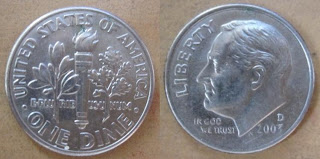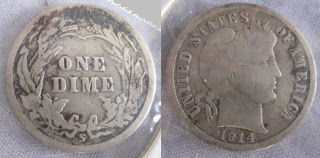Roosevelt dime, 2003

Upon his return from the Yalta Conference, President Franklin D. Roosevelt addressed a joint session of Congress on March 1, 1945. The President’s health was deteriorating rapidly. President Roosevelt went to a therapeutic spa he frequented since 1924 in Warm Springs, GA, for some much needed rest and recuperation. On April 12th, of the same year, he died.
Soon after the death of President Franklin D. Roosevelt in 1945, legislation was introduced by Virginia Congressman Ralph H. Daughton that called for the replacement of the Mercury dime with one bearing Roosevelt's image.The dime was chosen to honor Roosevelt partly due to his efforts in the founding of the National Foundation for Infantile Paralysis (later renamed the March of Dimes), which originally raised money for polio research and to aid victims of the disease and their families.The public had been urged to send in a dime to the Foundation, and by Roosevelt's death, the Foundation was already popularly known as the "March of Dimes."
Due to the limited amount of time available to design the new coin, the Roosevelt dime was the first regular-issue U.S. coin designed by a Mint employee in more than 40 years. Chief Engraver John R. Sinnock was chosen, as he had already designed a Mint presidential medal of Roosevelt. Sinnock's first design, submitted on October 12, 1945, was rejected, but a subsequent one was accepted on January 6, 1946.
The dime was released to the public on January 30, 1946, which would have been Roosevelt's 64th birthday. Sinnock's design placed his initials ("JS") at the base of Roosevelt's neck, on the coin's obverse. His reverse design elements of a torch, olive branch, and oak branch symbolized, respectively, liberty, peace, and victory.
Controversy immediately ensued, as strong anti-Communist sentiment in the United States led to the circulation of rumors that the "JS" engraved on the coin was the initials of Joseph Stalin, placed there by a Soviet agent in the mint.The Mint quickly issued a statement refuting this, confirming that the initials were indeed Sinnock's.
Another controversy surrounding Sinnock's design involves his image of Roosevelt. Soon after the coin's release, it was claimed that Sinnock borrowed his design of Roosevelt from a bas relief created by African American sculptor Selma Burke, unveiled at the Recorder of Deeds Building in Washington D.C. in September 1945. Sinnock denied this, claiming that he simply utilized his earlier design on the Roosevelt medal.
With the passage of the Coinage Act of 1965, the composition of the dime changed from 90 percent silver and 10 percent copper to a clad "sandwich" of copper between two layers of an alloy of 91.67 percent copper and 8.33 percent nickel.
Mercury dime, 1916
 Although most commonly referred to as the "Mercury" dime, the coin does not depict the Roman messenger god. The obverse figure is a depiction of the mythological goddess Liberty wearing a Phrygian cap, a classic symbol of liberty and freedom, with its wings intended to symbolize freedom of thought. Designed by noted sculptor Adolph A. Weinman, the Winged Liberty Head dime is considered by many to be one of the most beautiful U.S. coin designs ever produced. The composition (90 percent silver, 10 percent copper) and diameter (17.9 millimeters) of the "Mercury" dime was unchanged from the Barber dime.
Although most commonly referred to as the "Mercury" dime, the coin does not depict the Roman messenger god. The obverse figure is a depiction of the mythological goddess Liberty wearing a Phrygian cap, a classic symbol of liberty and freedom, with its wings intended to symbolize freedom of thought. Designed by noted sculptor Adolph A. Weinman, the Winged Liberty Head dime is considered by many to be one of the most beautiful U.S. coin designs ever produced. The composition (90 percent silver, 10 percent copper) and diameter (17.9 millimeters) of the "Mercury" dime was unchanged from the Barber dime.Weinman (who had studied under Augustus Saint-Gaudens) won a 1915 competition against two other artists for the design job, and is thought to have modeled his version of Liberty on Elsie Kachel Stevens, wife of noted poet Wallace Stevens. The reverse design, a fasces juxtaposed with an olive branch, was intended to symbolize America's readiness for war, combined with its desire for peace. Although the fasces symbol was later adopted by Benito Mussolini and his National Fascist Party, the symbol was quite common in American iconography and has generally avoided any stigma associated with its usage in wartime Italy.
This coin was minted in silver.
Barber dime, 1914
 As early as 1879, public dissatisfaction with the Seated Liberty design was heard in Washington and Philadelphia. It was felt by many that the nation's coin designs were second-rate, but few could have predicted how mundane a change could really be. New designs were submitted by Mint engravers throughout the early 1880s, but the only outcome was the production of a new nickel in 1883 designed by Chief Engraver Charles Barber. In 1891, when there was much discussion of a public competition for new designs for the dime, quarter dollar and half dollar, Barber reported to Mint Director James Kimball that there was no one in the country who was capable of assisting him in preparing original designs.
As early as 1879, public dissatisfaction with the Seated Liberty design was heard in Washington and Philadelphia. It was felt by many that the nation's coin designs were second-rate, but few could have predicted how mundane a change could really be. New designs were submitted by Mint engravers throughout the early 1880s, but the only outcome was the production of a new nickel in 1883 designed by Chief Engraver Charles Barber. In 1891, when there was much discussion of a public competition for new designs for the dime, quarter dollar and half dollar, Barber reported to Mint Director James Kimball that there was no one in the country who was capable of assisting him in preparing original designs.What Barber did accomplish with his new dime, though, was to design and place into production a coin that would meet the striking requirements of modern, high-speed coin presses. As a Mint employee he was acutely aware of the need for coins to be designed so they would strike up with one blow from the coin press. His objection to outsiders was, no doubt, due in part to jealousy, but in all fairness he did understand the exacting specifications required to strike millions of coins for commercial purposes.
The Barber dime, as with all previous dimes, featured an image of Liberty on the obverse. She is wearing a Phrygian cap, a laurel wreath with a ribbon, and a headband with the inscription "LIBERTY". This inscription is one of the key elements used in determining the condition of Barber dimes.
The Barber dime was minted in silver.



Very beautiful that's blog.
ReplyDelete